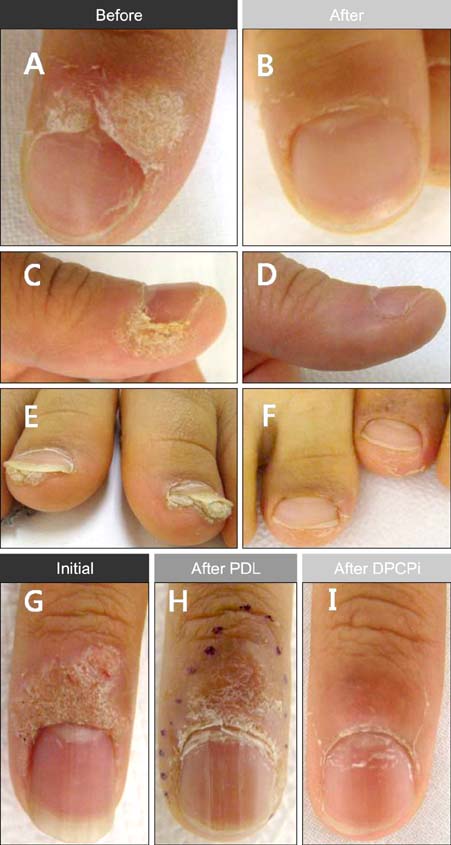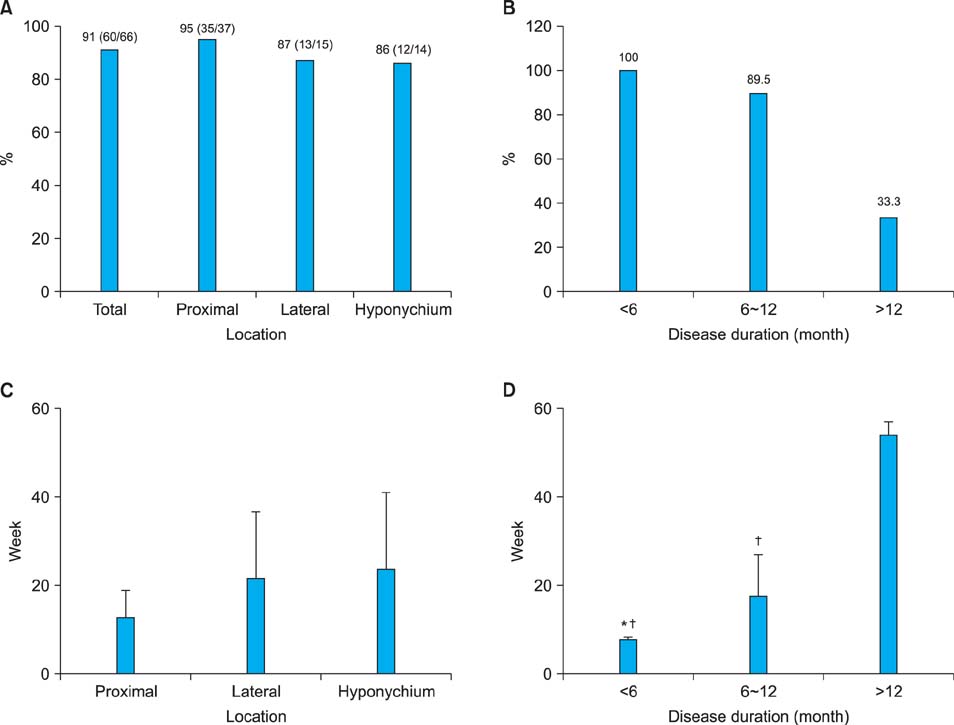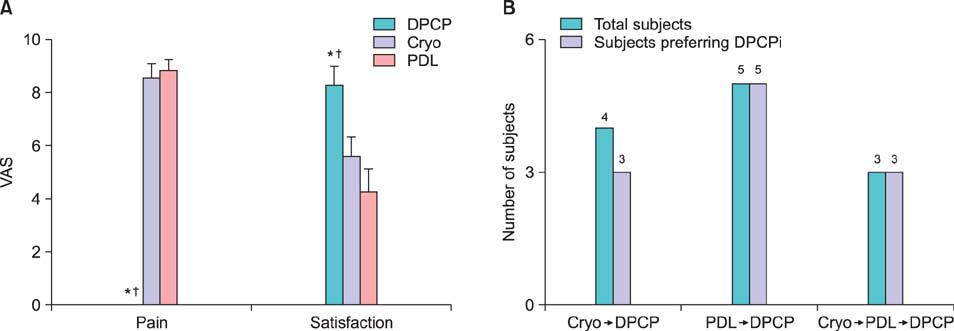Ann Dermatol.
2013 Nov;25(4):434-439. 10.5021/ad.2013.25.4.434.
Topical Immunotherapy with Diphenylcyclopropenone Is Effective and Preferred in the Treatment of Periungual Warts
- Affiliations
-
- 1Department of Dermatology, Dongguk University Ilsan Hospital, Dongguk University College of Medicine, Goyang, Korea. heydoc74@hanmail.net
- KMID: 2265051
- DOI: http://doi.org/10.5021/ad.2013.25.4.434
Abstract
- BACKGROUND
There exists a treatment challenge with periungual warts. Topical immunotherapy with diphenylcyclopropenone (DPCP) has recently been reported to be an effective treatment for recalcitrant warts, including periungual types.
OBJECTIVE
We aimed to evaluate the effectiveness and preference of topical immunotherapy with DPCP in treating periungual warts.
METHODS
Twenty-seven patients with periungual warts who were treated with DPCP immunotherapy (2007 through 2010; Dongguk University Ilsan Hospital, Goyang, Korea) were retrospectively recruited. Other treatment modalities were also used in some patients. Lesions were grouped into the types according to the following locations: proximal nail fold, lateral nail fold and hyponychium. Total and group clearance rates as well as treatment periods according to location and disease duration were evaluated. A patient questionnaire was performed to assess the satisfaction for the treatments in those who received multiple therapies.
RESULTS
Total success rates were 85% (by subjects) and 91% (by individual lesions). Success rate and treatment period for proximal nail fold type seemed more desirable than other locations. Success rate decreased and treatment period increased as disease duration increased. The questionnaire revealed a significantly higher satisfaction rate for DPCP immunotherapy than for cryotherapy and pulsed-dye laser.
CONCLUSION
Topical immunotherapy with DPCP is an effective and preferred method in the treatment of periungual warts.
MeSH Terms
Figure
Cited by 1 articles
-
Attenuated Nuclear Factor Kappa B Activity by E7 Protein of Human Papillomavirus Type 2 in Human Epidermal Keratinocytes
Yun Hee Ryu, Ju Hee Han, Ji Hyun Lee, Soon Young Choi, Young Min Park
Ann Dermatol. 2017;29(3):367-370. doi: 10.5021/ad.2017.29.3.367.
Reference
-
1. Kuflik EG. Specific indications for cryosurgery of the nail unit. Myxoid cysts and periungual verrucae. J Dermatol Surg Oncol. 1992; 18:702–706.
Article2. Ross BS, Levine VJ, Nehal K, Tse Y, Ashinoff R. Pulsed dye laser treatment of warts: an update. Dermatol Surg. 1999; 25:377–380.
Article3. Oni G, Mahaffey PJ. Treatment of recalcitrant warts with the carbon dioxide laser using an excision technique. J Cosmet Laser Ther. 2011; 13:231–236.
Article4. Lim JT, Goh CL. Carbon dioxide laser treatment of periungual and subungual viral warts. Australas J Dermatol. 1992; 33:87–91.
Article5. Atzori L, Pinna AL, Ferreli C. Extensive and recalcitrant verrucae vulgares of the great toe treated with imiquimod 5% cream. J Eur Acad Dermatol Venereol. 2003; 17:366–367.
Article6. Gooptu C, Higgins CR, James MP. Treatment of viral warts with cimetidine: an open-label study. Clin Exp Dermatol. 2000; 25:183–185.
Article7. Munn SE, Higgins E, Marshall M, Clement M. A new method of intralesional bleomycin therapy in the treatment of recalcitrant warts. Br J Dermatol. 1996; 135:969–971.
Article8. Upitis JA, Krol A. The use of diphenylcyclopropenone in the treatment of recalcitrant warts. J Cutan Med Surg. 2002; 6:214–217.
Article9. Rampen FH, Steijlen PM. Diphencyprone in the management of refractory palmoplantar and periungual warts: an open study. Dermatology. 1996; 193:236–238.
Article10. Buckley DA, Keane FM, Munn SE, Fuller LC, Higgins EM, Du Vivier AW. Recalcitrant viral warts treated by diphencyprone immunotherapy. Br J Dermatol. 1999; 141:292–296.
Article11. Laurent R, Kienzler JL. Epidemiology of HPV infections. Clin Dermatol. 1985; 3:64–70.
Article12. Aum HS, Kim YH, Kim DH. Study of pulsed dye laser followed by intralesional bleomycin treatment compared to lone intralesional bleomycin treatment for recalcitrant periungual warts. Korean J Dermatol. 2006; 44:45–50.13. Moghaddas N. Periungual verrucae diagnosis and treatment. Clin Podiatr Med Surg. 2004; 21:651–661.
Article14. Lewis HM. Topical immunotherapy of refractory warts. Cutis. 1973; 12:863–867.15. Wiesner-Menzel L, Happle R. Regression of plantar warts following treatment with diphencyprone. Z Hautkr. 1984; 59:1080–1083.16. Lane PR, Hogan DJ. Diphencyprone. J Am Acad Dermatol. 1988; 19:364–365.
Article17. van der Steen P, van de Kerkhof P, der Kinderen D, van Vlijmen I, Happle R. Clinical and immunohistochemical responses of plantar warts to topical immunotherapy with diphenylcyclopropenone. J Dermatol. 1991; 18:330–333.
Article18. Park HS, Choi WS. Pulsed dye laser treatment for viral warts: a study of 120 patients. J Dermatol. 2008; 35:491–498.
Article19. Naylor MF, Neldner KH, Yarbrough GK, Rosio TJ, Iriondo M, Yeary J. Contact immunotherapy of resistant warts. J Am Acad Dermatol. 1988; 19:679–683.
Article20. Orecchia G, Douville H, Santagostino L, Rabbiosi G. Treatment of multiple relapsing warts with diphenciprone. Dermatologica. 1988; 177:225–231.
Article21. Puig L, Alegre M, Cuatrecasas M, De Moragas JM. Erythema multiforme-like reaction following diphencyprone treatment of plane warts. Int J Dermatol. 1994; 33:201–203.
Article22. Monk B. Induction of hair growth in alopecia totalis with diphencyprone sensitization. Clin Exp Dermatol. 1989; 14:154–157.
Article23. Henderson CA, Ilchyshyn A. Vitiligo complicating diphencyprone sensitization therapy for alopecia universalis. Br J Dermatol. 1995; 133:496–497.
Article
- Full Text Links
- Actions
-
Cited
- CITED
-
- Close
- Share
- Similar articles
-
- Efficacy of Diphenylcyclopropenone Immunotherapy for Wart Based on Anatomical Location
- The Effect of Diphenylcyclopropenone Immunotherapy on Molluscum Contagiosum
- Does Immunotherapy of Viral Warts Provide Beneficial Effects When It Is Combined with Conventional Therapy?
- Treatment of Recalcitrant Viral Warts with Combination Therapy of Systemic Acitretin and Diphenylcyclopropenone Immunotherapy
- Proper Concentration of Diphenylcyclopropenone Solution according to the Anatomical Location and Application Time Interval for the Treatment of Warts





